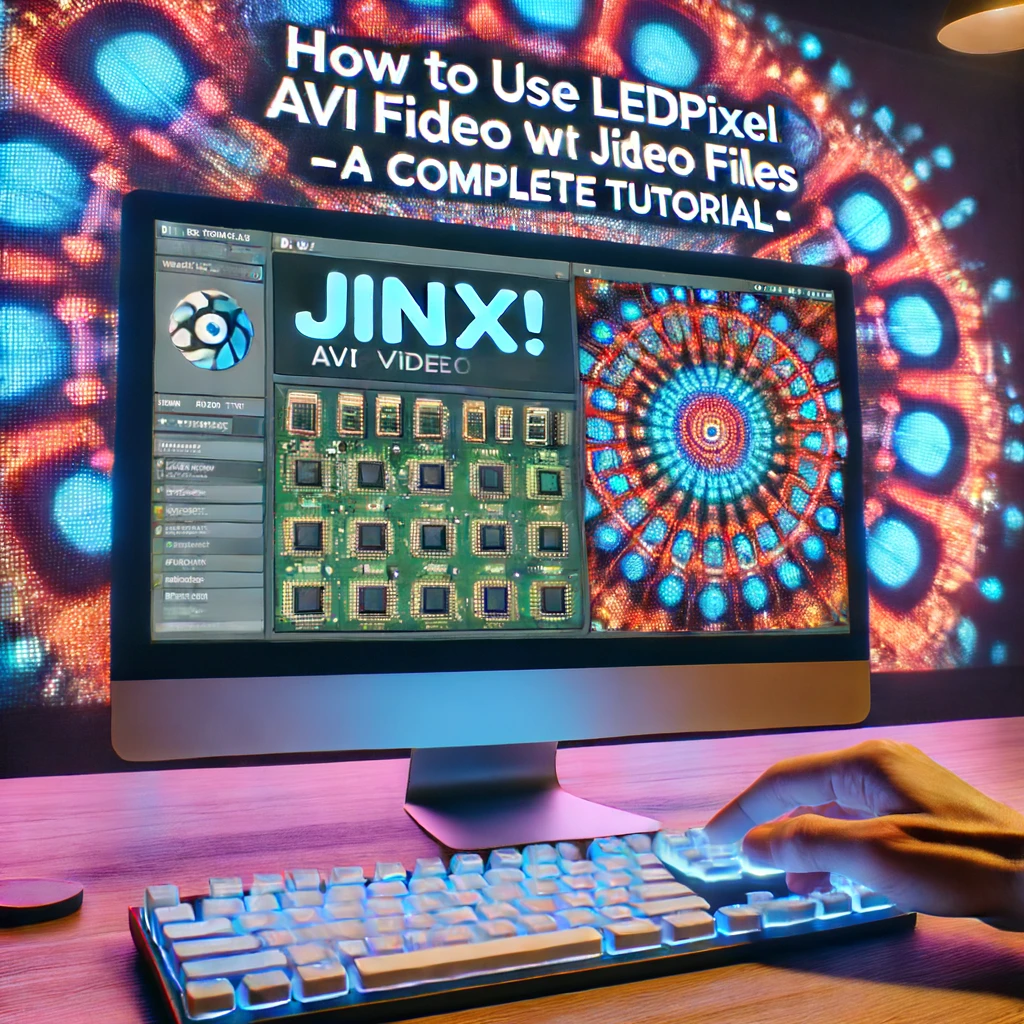Creating stunning LED displays can be greatly simplified by using LEDPixel.net AVI video files with JINX!. This tutorial will guide you through the steps to effectively use these resources to achieve mesmerizing visual effects for your LED panels.

What You Will Need
Before we start, make sure you have the following:
- An LED display setup compatible with JINX!
- JINX! software installed on your computer
- AVI video files from LEDPixel.net
- A basic understanding of how to operate JINX!
Step 1: Download LEDPixel.net AVI Video Files
LEDPixel.net provides a pack of high-quality AVI video files designed specifically for Pixel LED displays. Follow these steps to get started:
- Visit LEDPixel.net: Open your web browser and go to LEDPixel.net.
- Browse Video Packs: Explore the available AVI video packs and choose the ones that best suit your display needs.
- Download Files: Download the selected AVI video files to your computer. Make sure to note the location where the files are saved.
Step 2: Set Up JINX! for Your LED Display
JINX! is a powerful software for creating and managing LED light shows. Here’s how to configure it for your downloaded AVI files:
- Open JINX!: Launch the JINX! software on your computer.
- Configure Your Output: Go to
Setup > Output Patchand configure the output settings according to your LED display hardware. - Load AVI Files: In the JINX! interface, navigate to the
Effectstab and selectAVI. Browse to the location of your downloaded LEDPixel.net AVI files and load them into JINX!.
Step 3: Play and Control Your AVI Video Files
With your AVI files loaded into JINX!, you can now control and play them on your LED display.
- Select Your Video: In the JINX! interface, select the loaded AVI video file from the list of effects.
- Configure Playback Settings: Adjust playback settings such as speed, brightness, and looping to suit your display requirements.
- Start the Show: Click the play button to start displaying the video on your LED panels. Enjoy the captivating visuals created by the LEDPixel.net AVI files.
Tips for a Successful Setup
- Optimize Display Settings: Ensure that your JINX! output settings match the resolution and frame rate of your LED panels for optimal performance.
- Preview and Test: Always preview and test the AVI files on your LED display before the final presentation to ensure everything works as expected.
- Adjust Brightness and Speed: Fine-tune the brightness and playback speed settings in JINX! to achieve the desired visual effect.
Troubleshooting Common Issues
- Playback Issues: If you experience playback issues, check the compatibility of the AVI files with your JINX! settings. Ensure the files are not corrupted and are properly loaded.
- Synchronization: Ensure that your LED panels are properly synchronized with JINX! to avoid any lag or mismatched effects.
- File Compatibility: Verify that the AVI files from LEDPixel.net are compatible with your version of JINX!. Updating to the latest version of JINX! may resolve compatibility issues.
Troubleshooting: “Unsupported Codec” Error in JINX! for AVI Files
If your AVI files won’t play in JINX! and you’re seeing the message “maybe an unsupported codec,” it means that the necessary Video for Windows (VfW) codecs are not installed on your system. The AVI player inside JINX! relies on the VfW API, so you’ll need to install these codecs to play your AVI files correctly.
Step 1: Install the ffdshow Codecs
The best starting point is to install the ffdshow codecs, which can be downloaded from ffdshow-tryout.sourceforge.net.
- Download ffdshow: Visit the ffdshow download page and download the latest stable release.
- Run the Installer: During the installation process, make sure to activate the “VfW Interface.” This step is crucial to ensure that the necessary VfW codecs are installed.
Step 2: Configure VfW Codecs
After installing the ffdshow codecs, you need to configure them to activate the necessary codecs for your AVI files.
- Start VfW Configuration: Open the ffdshow VfW configuration tool.
- Activate Codecs: In the configuration window, navigate to the “Decoder” tab. In the left pane, click on “Codecs.”
- Set All Stable Formats to libavcodec: Right-click in the right pane and select “Set all stable formats to libavcodec.” This action will activate nearly all the codecs you need to play AVI files within JINX!.
Step 3: Special Considerations for Windows 8 and 8.1
If you’re using Windows 8 or 8.1, there is a known bug in the newer releases of ffdshow that may prevent the VfW codecs from installing correctly. To workaround this issue:
- Download an Older Release: Use an older release of ffdshow, such as
ffdshow_rev4499_20130104_clsid.exe. - Install and Configure: Follow the same installation and configuration steps outlined above.
Now you should be able to resolve the “unsupported codec” error and play your AVI files in JINX! without any issues. Ensure that all necessary codecs are activated and correctly configured to enjoy seamless playback of your LED animations.
This revised troubleshooting guide should help you address the “unsupported codec” issue in JINX! and ensure your AVI files play correctly.
By following these steps, you can effectively use LEDPixel.net AVI video files with JINX! to create stunning visual displays on your Pixel LED panels. Experiment with different video packs and settings to find the perfect combination for your LED show.
This revised tutorial should be more aligned with the intended use of LEDPixel.net as a source of AVI video files for use with JINX!.